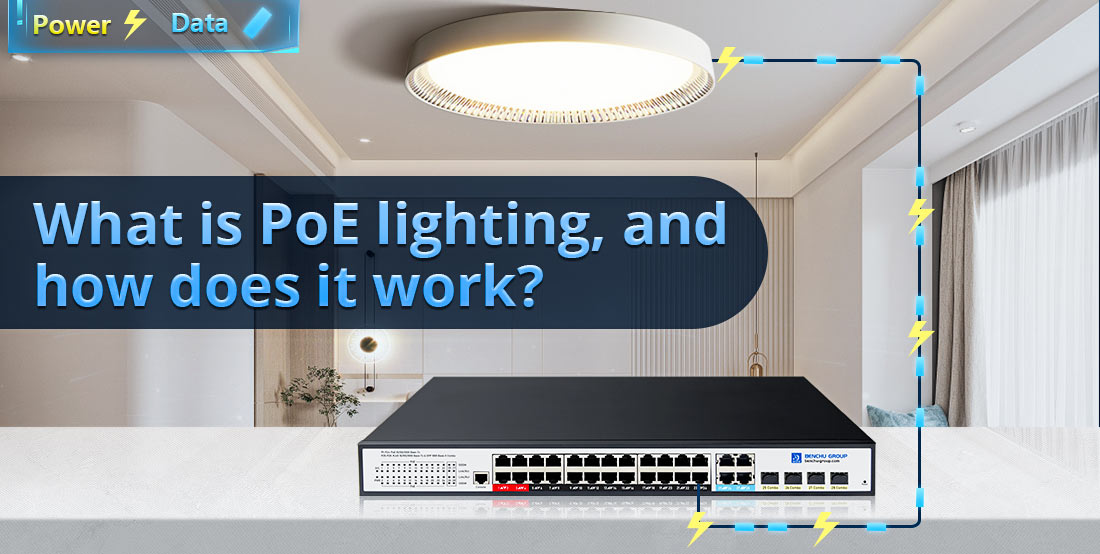
PoE lighting refers to lighting systems that are powered and controlled using Power over Ethernet (PoE) technology. Instead of relying on traditional electrical wiring, PoE lighting fixtures receive both power and data over standard Ethernet cables (typically Cat5e or Cat6). This enables centralized control, energy efficiency, and simplified installation, making it ideal for modern smart buildings, offices, and industrial spaces.
How PoE Lighting Works:
1.PoE Switch or Injector: The PoE switch or injector supplies both power and data to the lighting system via Ethernet cables.
2.LED Fixtures: PoE lighting systems typically use LED (Light Emitting Diode) fixtures, as LEDs are energy-efficient and can operate with the lower power levels provided by PoE.
3.Control and Data Integration: The same Ethernet cable delivers data, enabling centralized control of the lighting system. This allows for advanced features like dimming, scheduling, occupancy sensing, and integration with building automation systems.
4.Network-Based Management: The lighting system can be monitored and controlled remotely via software, which allows for adjustments in real time, energy consumption tracking, and automation based on occupancy, daylight, or predefined schedules.
Key Components of a PoE Lighting System:
--- PoE Switch/Injector: Provides the necessary power (typically 15W to 60W per port, depending on the PoE standard) and data connectivity to the lighting fixtures.
--- PoE-Compatible LED Lights: Specially designed LED light fixtures that are compatible with PoE input and can be powered by low-voltage Ethernet cables.
--- Control Software: Allows centralized or remote management of the lighting system, enabling features like scheduling, occupancy sensing, and energy monitoring.
--- Sensors and Controls: PoE lighting systems often integrate with occupancy sensors, daylight sensors, and wall-mounted switches that also connect to the network, allowing automated or manual control of the lights.
How PoE Lighting Operates:
--- Power Delivery: PoE supplies low-voltage power (up to 60 watts per device with PoE+) to LED lights, which consume significantly less power than traditional lighting systems.
--- Data Transmission: Through the same Ethernet cable, data signals allow the lights to be controlled centrally. This data can be used to adjust brightness levels, control individual or groups of lights, and monitor energy usage.
--- Automation and Intelligence: The system can integrate with other smart building technologies, allowing lights to respond to occupancy sensors, daylight levels, or even user preferences. For instance, lights can automatically dim or turn off in unused spaces to conserve energy.
Benefits of PoE Lighting:
1.Energy Efficiency:
--- LEDs are highly energy-efficient, and PoE lighting systems can optimize energy use by providing precise control over brightness, scheduling, and automatic responses to occupancy and daylight.
2.Simplified Installation:
--- PoE lighting uses standard Ethernet cables, which are cheaper and easier to install than traditional electrical wiring. This makes installation more straightforward and less labor-intensive.
--- No need for licensed electricians, as Ethernet cabling is low voltage and safer to handle during installation.
3.Centralized Management:
--- PoE lighting systems are network-based, allowing centralized control from a single interface. Administrators can adjust lighting remotely, automate schedules, and monitor energy usage.
--- Integration with other building management systems (BMS) allows for seamless control of HVAC, security, and lighting systems from one platform.
4.Flexibility and Scalability:
--- PoE lighting systems are highly flexible, making it easy to reconfigure lighting layouts without rewiring, which is particularly useful in dynamic environments like offices or retail spaces.
--- Adding new lighting fixtures or expanding the system is simple, as additional lights can be plugged into the existing Ethernet network without complex electrical work.
5.Enhanced Safety:
--- Ethernet cables carry low voltage, making PoE lighting installations safer and reducing the risk of electrical fires. This is particularly beneficial in sensitive environments like healthcare facilities.
6.Smart Building Integration:
--- PoE lighting systems can be integrated with other IoT devices and smart building systems. For example, occupancy sensors can automatically adjust lighting levels based on the presence of people, while daylight sensors can adjust brightness to maximize natural light usage.
Use Cases of PoE Lighting:
--- Offices: Centralized control, scheduling, and automation make PoE lighting systems perfect for modern office spaces. Lights can be programmed to adjust based on working hours, occupancy, or employee preferences.
--- Smart Buildings: PoE lighting is a key component of smart building ecosystems, integrating with other building systems for energy efficiency and occupant comfort.
--- Healthcare Facilities: In hospitals or clinics, PoE lighting can be customized to create ideal lighting conditions for various settings (e.g., patient rooms, operating rooms) and allow for remote management and reduced energy consumption.
--- Warehouses and Industrial Spaces: These spaces benefit from centralized control, easy maintenance, and flexible deployment options that PoE lighting provides.
Conclusion:
PoE lighting systems offer a modern, energy-efficient, and cost-effective solution for managing lighting in commercial buildings, smart homes, and industrial settings. By combining power and data over a single Ethernet cable, PoE lighting simplifies installation, enables sophisticated control features, and integrates seamlessly with other smart building technologies, making it a key technology for the future of building management.